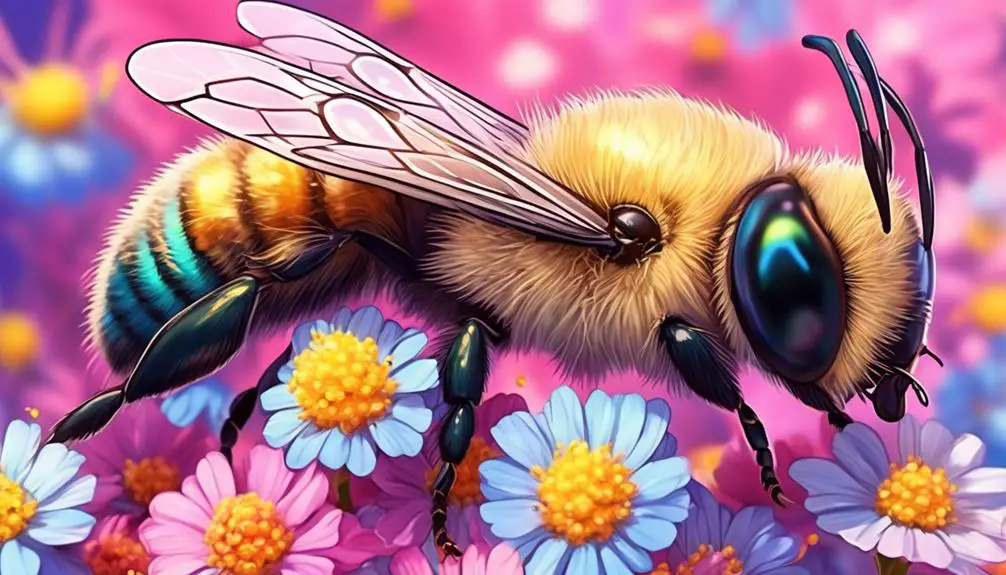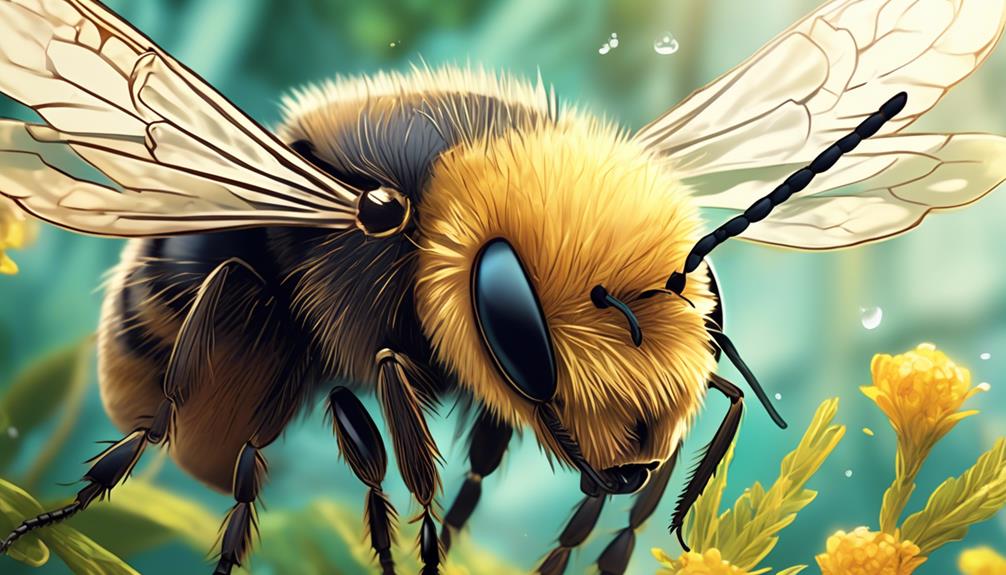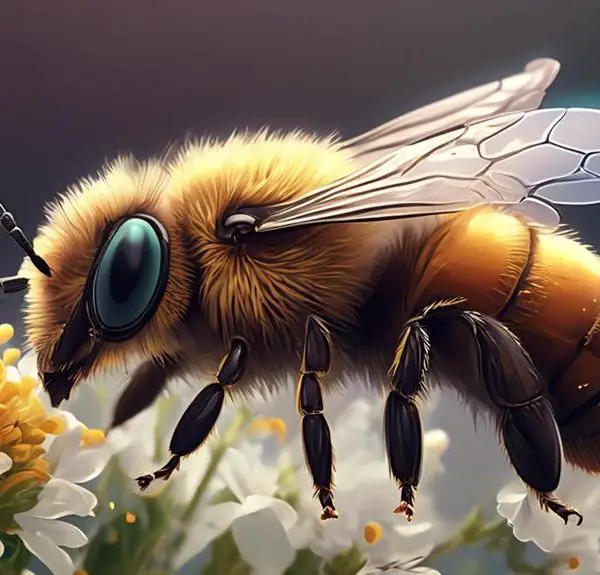Wondering whether Mason bees are equipped with mandibles? Dive into the fascinating world of these insect's survival tools!

Do Mason Bees Have Mandibles?
You've likely heard the theory that Mason bees, like their other bee counterparts, have mandibles. But is this actually true?
Mandibles—those jaw-like appendages insects use for everything from eating to building—are a fascinating aspect of insect anatomy.
In the case of Mason bees, these little tools are said to play an instrumental role in their survival. They're used not only for foraging for nectar but also for constructing intricate nests out of mud.
But let's not get ahead of ourselves. Before we accept this as fact, it's essential to scrutinize this theory thoroughly. After all, who wouldn't want to know more about these fascinating creatures and the tools that aid their survival?
Key Takeaways
- Mason bees have powerful mandibles made of chitin that are used for feeding, nesting, defense, and mating.
- The shape and structure of mason bee mandibles are specially adapted for their mud-based nest-building behavior.
- Mandibles are vital organs for the survival, reproduction, and daily living of mason bees.
- Mandibles play a significant role in bee communication, including reinforcing messages during the waggle dance and transferring food or fluids among colony members.
Understanding Mason Bee Anatomy

To fully appreciate the efficiency of Mason bees, let's delve into the intricacies of their anatomy, beginning with their formidable mandibles. These powerful tools, located on either side of their mouths, serve multiple purposes. They're not just for chewing, but they're also used for cutting, digging, and even fighting, when necessary. The mandibles are made of chitin, a durable, flexible material that's also found in the exoskeletons of many insects.
You'll also find that Mason bees have antennae, which aren't just for show. They're highly sensitive organs for detecting scents and vibrations. This helps them locate flowers for feeding and potential sites for nesting.
As you move down the body, you'll notice two pairs of wings. The front pair is larger, aiding in flight, while the back pair provides balance. Between the wings, you'll find the bee's spiracles or breathing tubes. These tiny holes allow oxygen to enter the bee's body and carbon dioxide to exit, facilitating respiration.
Lastly, we can't ignore the bee's abdomen, housing vital organs like the reproductive system and digestive tract. Examining these aspects of Mason bee anatomy offers a glimpse into the efficiency and complexity of these industrious insects.
Exploring the Function of Mandibles

Now that you've got a grasp on the general anatomy of Mason bees, let's narrow our focus to the function of their mandibles, these impressive tools that are far more than mere eating utensils.
The primary function of the mandibles is for mastication, or chewing. However, they're not limited to just that. These hard, jaw-like structures play a vital role in a variety of behaviors related to survival and reproduction.
Let's dive deeper. Consider the following:
Use | Description | Importance |
|---|---|---|
Feeding | Mandibles crush and mold pollen into "bee bread". | Essential for nutrition. |
Nesting | They shape mud into cells for offspring. | Key for reproduction. |
Defense | Bees use them to ward off predators. | Crucial for survival. |
Mating | Males grasp females during mating. | Vital for species continuation. |
Thus, mandibles are multi-functional tools central to the Mason bee's existence. They're not just for eating; they're tools for survival, tools for creation, and tools for continuation. Understanding their function gives us a glimpse into the fascinating world of these industrious creatures. Remember, every part of a bee's anatomy has its purpose, and the mandibles are no exception.
Mason Bees and Their Unique Mandibles

Delving into the uniqueness of Mason bees' mandibles, you'll discover a world where these miniature power-tools exhibit remarkable adaptability, demonstrating evolution's ingenious design solutions. These mandibles aren't just for chewing, they're also used for cutting, shaping, and transporting materials.
Unlike their bee relatives, Mason bees have strong, broad mandibles. These are specially adapted for their nest-building behavior, where they utilize mud to construct their homes. The mandibles' robust design allows them to efficiently gather, mold, and transport mud. The shape and structure of these mandibles are species-specific, reflecting their particular ecological needs and habitat conditions.
Further, you'll find that these mandibles aid in their mating practices. Males use them to hold on to females during copulation, ensuring successful reproduction. It's an evolutionary adaptation that's both practical and fascinating, showing how these tiny creatures have evolved to survive and thrive in their environments.
Examining these unique mandibles, it's clear that they play a vital role in the life of a Mason bee. They're not just an appendage, but a multifunctional tool, integral to their survival. This exploration underlines the marvelous adaptability of nature, and how even the smallest creatures are equipped with finely tuned, specialized tools.
The Role of Mandibles in Bee Survival

While you might consider mandibles as mere mouthparts, for bees, particularly the Mason bee, they serve as essential survival tools, aiding in everything from nest-building and food gathering to mating rituals.
To understand their significance, it's essential to grasp the functionality of a bee's mandible. It's not just a tool for chewing or cutting; it's a multi-purpose device used in myriad ways. For instance, a Mason bee uses its mandibles to collect mud to construct its nest, displaying the intricate relationship between physical adaptations and survival strategies.
During the mating process, the male bee's mandibles play a crucial role. They're used to firmly grasp the female during copulation, ensuring the continuation of their species.
Moreover, mandibles are used in self-defense. When threatened, a bee can pinch its predator, deterring potential attacks. They're also used to clean their antennae, crucial for maintaining their sensory abilities.
In essence, the mandibles' versatility showcases the intricate design and functionality of these bees. They're not simply an appendage but a vital organ for survival, reproduction, and daily living. So, next time you think of a bee's mandibles, remember that they're far more than just 'mouthparts.'
Mandibles Contribution in Bee Communication

Building on the multifaceted role of mandibles in a bee's life, it's fascinating to note that they also contribute significantly to bee communication.
You may be wondering, how do bees converse using mandibles? Let's dive into this intriguing subject.
Mandibles help bees express a range of signals. For instance, during the waggle dance, a form of communication where bees share the location of a food source, the dancer bee uses her mandibles to grasp the recipient bee, reinforcing the message.
Moreover, mandibles play a role in trophallaxis – the transfer of food or other fluids among colony members. When a worker bee needs to share food with another bee, it uses its mandibles to open up and expose its proboscis, allowing the exchange of nectar.
Also, queen bees use their mandibles to signal their dominance, warding off rivals. By spreading pheromones using their mandibles, they mark their territory, ensuring their position is understood by the colony.
From these examples, you can see how mandibles aren't only tools for survival but also essential components of bee communication. Their role in interaction is complex, yet integral, revealing another fascinating aspect of bee behavior.
Conclusion
Indeed, mason bees do have mandibles. These unique features play a crucial role in their survival, serving various functions from gathering food to constructing nests.
Beyond survival, mandibles also facilitate communication between bees. Understanding the anatomy and functionality of mason bee mandibles offers a fascinating insight into their complex world.
So, next time you spot a mason bee, remember the vital role their mandibles play in their daily life.



